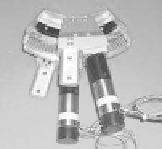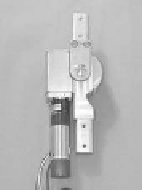Biomedical Engineering Reference
In-Depth Information
walking by simplifying the range of motion (ROM) of the hip joint to only one
direction of flexion and extension (limiting the DOF). In addition, the system has
no power source, and power exerted by the upper extremities is mostly used for
progression and lateral motion of the body during walking. Therefore, problems
have arisen that are related to the large burden placed on the upper extremities
and high energy consumption in walking, making practical use of these orthoses
difficult (Suzuki; (2007), Greene; (2003), Greene; (2000)). In addition, standing-up
and sitting-down motions with the fixed knee extension position of KAFOs are
difficult tasks for paraplegic patients.
As a method to overcome the limitation of the orthoses described above, it
is conceivable that actuators, power sources for movement of the lower extrem-
ities, could be attached to orthoses and control movement. In other words, gait
reconstruction would take place through use of a wearable robot as an evolutional
development in the design of orthoses. Nevertheless, considering the actual life of
paraplegic patients, wheelchair compatibility with a wearable robot is an essential
prerequisite for use of the orthosis. For these reasons, a medial system should be
adopted for a wearable robot.
We developed a wearable robot (Wearable Power-Assist Locomotor: WPAL)
that adopts a medial system and has 6 motors equipped at the bilateral hip, knee,
and ankle joints.
3.4.1 Basic Information of WPAL
Figure 3.6
shows the WPAL, as well as the hip, knee and ankle joints. Also shown
is a full frontal view of the orthosis. The WPAL is comprised of a robotic part
and an orthotic part. The robotic part is modular to enable mass production,
Hip joint
Knee joint
Figure 3.6
(WPAL) Wearable Power-Assist Locomotor. For color reference, see page 212.




















